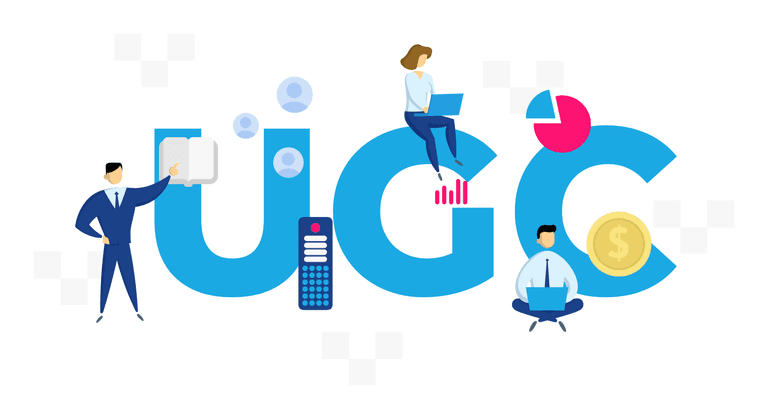Table of contents
- User Generated Content – definition
- User Generated Content in practice
- What are the benefits of User Generated Content?
- Types and examples of UGC-based campaigns
- User Generated Content and SEO
- Risks associated with User Generated Content
- User Generated Content – planning and strategy
- UGC – legal issues
- Is UGC the right strategy for your brand?

User Generated Content – what is UGC and how to use it in campaigns

Brands absolutely do not have a monopoly on content creation on the web. Although the Internet has been gradually professionalised (and monetised) over the past two decades, the vast majority of the content available and published on it still comes from ‘ordinary’ users. Is it possible to use them in online marketing? Of course it can! What is UGC and how can we creatively develop advertising campaigns using it?
User Generated Content – definition
User Generated Content (UGC), less commonly referred to as Customer Generated Media (CGM) and earned content, in the language of marketing, is content that relates to a brand, but is created by web users who are not connected to the brand – people who are not professionals (e.g. publishers, Influencers, journalists) and do not benefit financially from the creation and publication of their content.
Content must meet three conditions to be called UGC.
- It must not be created by a professional, i.e. someone affiliated with or employed by the brand. UGC is created by an independent, unpaid user – of their own free will.
- It is original – UGC is characterised by the creative contribution (OC – Original Content) of the author. It must carry some new value, not be duplicated content, on a copy-paste basis.
- User Generated Content must be publicly available on the web. Either on a website or on social media. Although in the latter case, it can also function in closed circles and groups .
UGC is not the result of a brand’s collaboration with an Influencer! A person recognised online can, of course, create content about their favourite brands, products and services for free, but in practice, due to the professionalisation of Influencer Marketing, this rarely happens
However, there are also some UGC campaigns in which Influencers are also involved, although they do not derive any benefit from this (apart from PR?). This was the case, for example, with the Ice Bucket Challenge.
In this particular case, the nature of the campaign is highly specific (charitable) and it is difficult to talk about the typical UGC that brands can use here.
User Generated Content in practice
User-generated content can take many forms and formats. They appear both on social media, on blogs and on websites designed to publish specific content (e.g. memes).
User Generated Content is primarily (but not exclusively!):
- comments (under blog posts and in social media),
- reviews, rankings, comparisons (also video)
- blog posts, articles in online magazines and zines,
- social media posts, tweets, brand or product images, testimonials, etc.
- content created as part of competitions,
- threads and posts on forums,
- wikipedia entries.
It is accepted that UGC is created by fans and brand ambassadors, but this is not always the case. If a campaign using User Generated Content achieves viral status, users are likely to be more tempted to participate in something that is currently top of mind than to show their affection for the brand.
What are the benefits of User Generated Content?
There is no shortage of statistics and data that prove the huge impact of bottom-up generated content on marketing effectiveness and increased conversions. Here are a handful of them:
- The CTR of ads based on user-generated content is up to four times higher than the CTR of other campaigns. Their CPC is reduced by up to 50%,
- Organic traffic can increase by up to 400% through the use of UGC,
- UGC influences consumer decisions almost 10 times more than content created by Influencers,
- Almost 80% of consumers admit that UGC influences their purchasing decisions,
- Ads using UGC are statistically 73% better rated than other ads,
- Over 60% of consumers believe UGC is the most authentic form of advertising,
- 93% of consumers agree that UGC is an aid to their purchasing decision.
- According to research by Photoslurp, User Generated Content can be an opportunity to increase conversion rates by an average of 15%.
User Generated Content therefore translates realistically into sales success, but not only! It can also influence many other important areas of a company’s online presence. Among the most important we can include:
Brand trust
Do you trust an advert more or a friend’s recommendation?
Almost every consumer is willing to trust another consumer, but not necessarily a brand. This is why UGC is a well-liked and useful form of user experience. As the statistics quoted above prove, it is also considered much more authentic.
Greater reach
UGC brings high reach because users are more willing to engage with such campaigns than traditional ones. They like to compete with each other and share the content they have created. They also spend a lot of time consuming this type of content – for example, millenials spend up to five hours a day browsing content (mainly UGC) online.
More website traffic
User-generated content can be used to increase website traffic. In addition to the SEO and organic traffic benefits, we must not forget direct traffic, associated with increased recognition, and referrer traffic – from a wide variety of sources.
Lower costs
Although a UGC campaign needs to be planned, the content somewhat ‘creates itself’. The brand can save money on graphics, copy and other processes that usually have to be paid for in order to publish this type of content. You could say that User Generated Content is free.
Benefit for customers
Bottom-up generated content benefits brands, but also users. It mainly involves a sense of being important and noticed. This in turn increases engagement and influences purchasing decisions in a positive way.
Social Proof
UGC is one of the easiest ways to obtain and present credible social proof. If users find the time to create content about a brand, there is probably an idea behind it – strong and attractive enough to reward their efforts.
Types and examples of UGC-based campaigns
The variety of possibilities for campaigns based on the UGC concept is best illustrated by examples.
“Share the joy” – Coca Cola
One of the most popular UGC campaigns in history was Coca-Cola’s famous “Share a Coke”. You are certainly very familiar with this campaign, as it also resonated in Poland, but under the name “Share a Joy”. The brand encouraged users to share pictures of personalised bottles online. The effects are surprising:
- 3% increase in sales transactions,
- 4% increase in sales value,
- 870% increase in Facebook traffic,
- Sharing of 76,000 virtual Coca-Cola cans,
- 330 million impressions,
- 170,000 tweets,
Cat day – General Fresh
A UGC campaign doesn’t always have to be so ‘complicated’. One of the simplest ways to use user generated content is to encourage users to share content that doesn’t require much work or skill – such as photos. This can be done by almost any brand and, if done well, will significantly increase its reach.
Bananapedia – Bananki.co.uk
To encourage users to create UGC, you can also give them something in return. Bananapedia is an example of this. It is a wiki, or grassroots-created encyclopaedia on the Bananki portal, where you can get points (bananas) for playing. These points are then exchanged for various kinds of prizes.
The idea behind Bananapedia is simple – players who create content for the wiki (article, review, tutorial, video) receive extra bananas. At the time of writing this article, 3,673 pieces of content have already been added there.
“Birthday Pyjama Party” – MissiSleepy
Even more motivation to create UGC can come from competitions. Brands are keen to use this form of incentive because it usually does not require a large financial outlay, yet it significantly increases fan engagement and builds a large reach. An example is the competition organised by the MissiSleepy brand. It consisted of several tasks that encouraged users to be active on social media.
Ratings and reviews
Campaigns that make use of UGC can be extremely interesting and varied, but the most common form of this type of content should be considered the various ratings and reviews that appear online every day. This ranges from Google’s Consumer Reviews to elaborate video reviews on YouTube. These may not be very sophisticated content, but they have a great deal to offer – both from a business and consumer perspective.
For the customer, ratings and reviews are information about whether the product and brand are recommended by others. The more good reviews, the greater the chance that the consumer will decide to buy. This is particularly important for those people who come into contact with a brand or product for the first time.
For the brand, on the other hand, UGC in the form of ratings and reviews, as well as the Q&A section, is an opportunity to get a better idea of customer expectations. In addition – and perhaps most importantly – it has the potential to increase the effectiveness of SEO efforts.
User Generated Content and SEO
UGC positively influences SEO on several different levels.
The first of these is certainly content marketing: a constant flow of new content and links is essential for achieving high positions in Google, and reviews and testimonials of all kinds are, after all, unique content that does not cost the brand a penny to create and is at the same time valuable and fresh.
In addition, user generated content usually (necessarily) contains keywords that are directly related to your shop or products. Search engines will appreciate this.
It is also not insignificant that online shops that use the rating system already stand out from the competition at the level of Google search results. At the same time, they attract attention, increase their credibility and have a better chance of gaining traffic.
In SEO, you can also use the potential of Q&A sections, i.e. questions and answers about the product. By doing so, you will provide another constant source of content. You will build customer relationships and outreach, and get to know your customers’ concerns and expectations better. You may even find new, valuable keywords through this interaction that you can incorporate into your website optimisation.
Besides, your responses are likely to appear in Google Featured Snippets, another chance to gain more traffic and stand out in the SERPs.
UGC also has an impact on page visits in a fairly obvious way, by generating buzz (buzz) around the brand. The more mentions a brand gets online, but outside of its company pages, such as on social media, the higher the brand awareness will be. High should have a positive effect on increasing traffic.
Video reviews are also worth keeping an eye on. For many consumers, they are the most authentic and helpful form of review, and the only one in which they see the product and the other person. Such an item stands out from the rest of the search results and can therefore result in increased traffic. You can add a video review to your site, thereby increasing the duration of the session and enhancing the appeal of your site.
Risks associated with User Generated Content
The biggest danger associated with UGC is the lack of brand control over the contexts in which it is placed. Unlike other online marketing methods, here you cannot be sure that the content generated will work for your brand. You have to reckon with negative reviews as well as spam, heckling and trolling.
These problems can be partially eliminated by hiring a moderator. He or she will prove indispensable, especially for big brands that are talked about a lot and those with a controversial image.
Anti-spam plug-ins can help, giving you a little more control over comments, reviews and discussions.
It is also advisable to use nofollow tags for links in user-generated content or to block outbound links altogether. This will ensure that your website is not linking to any potentially dodgy sites, which could negatively affect its rankings in Google.
User Generated Content – planning and strategy
How you use UGC depends on what your expectations are and what type of content you care most about. In the case of a comprehensive campaign, a proper plan will be necessary – your strategy taking into account objectives, resources, logistics.
A schematic process for planning your strategy should include at least five points.
Campaign objective
Your objectives may include, but are not limited to: increasing your reach, promoting your brand or a product of your brand, increasing brand awareness and trust, specific conversions.
Campaign audiences and their needs
The most popular UGC is always the one that responds to the needs of the audience and is in line with their expectations. You need to consider, among other things, what age they are, what communication channels they prefer, what interests them. Preparing a persona can help you to better understand your audience.
Type of action
Depending on what your objectives are and what forms your target group prefers, choose the type of UGC action. A comprehensive promotional campaign? A competition? Perhaps a campaign to encourage people to share a review?
Action plan and schedule
Determine: how long the campaign lasts, what content it covers, in which channels it will run. Pre-plan the form and flow of the campaign.
Once you know what you want your campaign to look like and what it should cover, you can prepare a schedule. This is the stage where you need to organise everything in terms of individual tasks. The more detail, the better.
Promotion
If you have the budget, consider paid promotion for your UGC campaign. However, remember not to overdo it, especially if you want a natural buzz around the campaign. Run the promotion where your audience is giving, in the form they prefer.
UGC – legal issues
When planning a campaign using User Generated Content, you need to bear in mind the issue of content copyright. You cannot use them unless you have obtained the authors’ permission to do so.
How do you obtain the rights to the content created as part of a UGC campaign?
All you have to do is ask for the possibility to use the content. Alternatively, communicate on social media that participation in the campaign constitutes consent to use the content (i.e. you give implicit consent). Importantly, this does not mean that you can use the content freely, e.g. in print advertising. Instead, you can easily share it on your brand profile or in testimonials.
In the case of more complex campaigns (e.g. competitions), it is advisable to specify the transfer of rights in the terms and conditions.
Is UGC the right strategy for your brand?
The potential of the User Generated Content method is great, but to make the most of it, you need to plan everything carefully. Industry, brand communication, other marketing activities – these are just a drop in the ocean of factors to consider when planning UGC activities. Also, not every brand will be able to get its audience to be creative.
Does yours have this potential?
Contact form
Develop your brand

Rate content:
You may be interested in:







